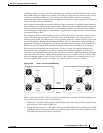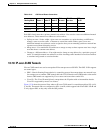
13-38
Cisco ONS 15454 Reference Manual, R7.0
78-17191-01
Chapter 13 Management Network Connectivity
13.7 13.7.5 TARP
13.7.5.1 TARP Processing
A TARP data cache (TDC) is created at each NE to facilitate TARP processing. In CTC, the TDC is
displayed and managed on the node view Maintenance > OSI > TDC subtab. The TDC subtab contains
the following TARP PDU fields:
• TID—TID of the originating NE (tar-tor).
• NSAP—NSAP of the originating NE.
• Type— Indicates whether the TARP PDU was created through the TARP propagation process
(dynamic) or manually created (static).
Provisionable timers, shown in Table 13-14, control TARP processing.
Table 13-15 shows the main TARP processes and the general sequence of events that occurs in each
process.
3 Sent as a response to Type 1, Type 2, or
Type 5 PDUs.
After a TARP Request (Type 1 or 2) PDU is received,
a TARP Type 3 PDU is sent to the request originator.
Type 3 PDUs do not use the TARP propagation
procedures.
4 Sent as a notification when a change
occurs locally, for example, a TID or
NSAP change. It might also be sent
when an NE initializes.
A Type 4 PDU is a notification of a TID or Protocol
Address change at the NE that originates the
notification. The PDU is sent to all adjacencies inside
and outside the NE’s routing area.
5 Sent when a device needs a TID that
corresponds to a specific NSAP.
When a Type 5 PDU is sent, the CLNP destination
address is known, so the PDU is sent to only that
address. Type 5 PDUs do not use the TARP
propagation procedures.
Table 13-13 TARP PDU Types (continued)
Type Description Actions
Table 13-14 TARP Timers
Timer Description
Default
(seconds)
Range
(seconds)
T1 Waiting for response to TARP Type 1 Request PDU 15 0–3600
T2 Waiting for response to TARP Type 2 Request PDU 25 0–3600
T3 Waiting for response to address resolution request 40 0–3600
T4 Timer starts when T2 expires (used during error recovery) 20 0–3600


















